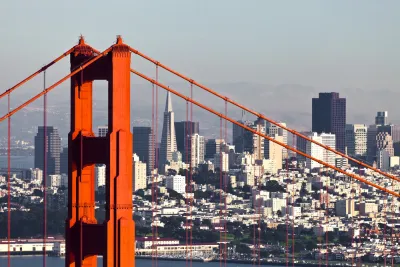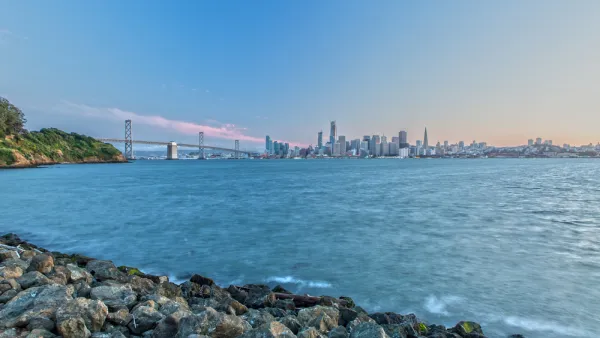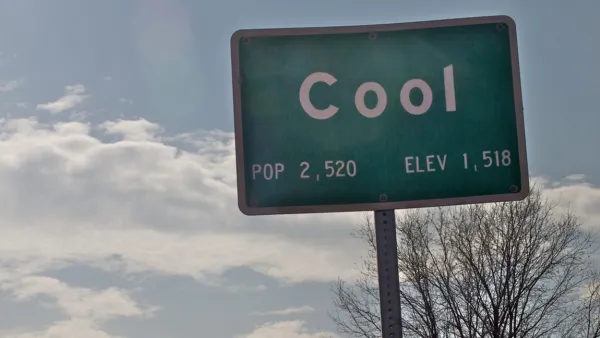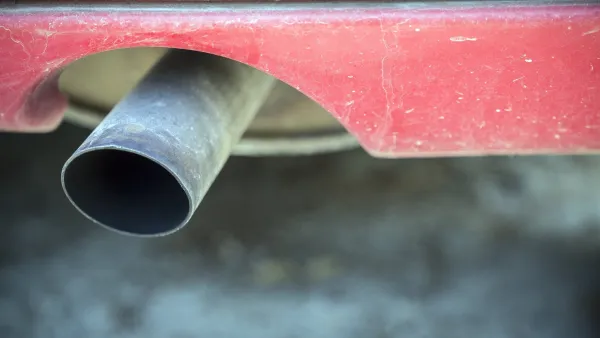California is demonstrating that improving the economy and the environment go hand in hand. A new inventory report from the state's Air Resources Board notes changes in gross domestic product, population, and greenhouse gas emissions since 2000.

A compelling chart introducing the new 2015 Greenhouse Gas (GHG) Emissions Inventory for the state of California illustrates the trends in the economy and the environment: GDP and population increase while greenhouse gas (GHG) emissions, GHG per capita, and GHG per GDP decrease.
"This data shows once again that California’s groundbreaking greenhouse gas emission-reduction programs are working as designed,” said Mary D. Nichols, chair of the California Air Resources Board (CARB). “These numbers clearly indicate that the state is on track to achieve its 2020 emission reduction goals and that California can grow its economy while continuing to fight climate change.”
The economic, if not the environmental, changes have not gone unnoticed, even by rival states such as Texas, reports Lydia DePillis, business reporter for the Houston Chronicle, on June 7.
For a few years, while California was dogged by a real estate crisis and state budget deficit and Texas' oil boom was just starting to take off, Texas had reason to brag.
But recently, those trends have reversed. The New Yorker traced California's return to economic health back in 2015, after Gov. Jerry Brown balanced the budget and a new tech boom took off.
DePillis points to several macroeconomic indicators to illustrate the reversal in the two state economies, including:
-
California's economy grew faster than Texas' in 2016, 2.9 percent to 0.4 percent.
-
Texas' unemployment rate bumped above California's this past March.
-
Average wages in California, which are already a few dollars an hour higher than in Texas, grew faster than they did in the Lone Star state for most of the past year.
Back to the progress report on reducing greenhouse gas emissions:
"California, the sixth-largest economy in the world, has advanced its nation-leading climate goals while also growing the economy," states the press release. [A caveat about that oft-quoted ranking: Politifact noted last year that when "adjusting for the state’s high cost of living, California’s GDP ranking drops to 11th in the world, according to the California Legislative Analyst’s Office."].
Four programs are largely credited for putting the state on track to meeting the goal of reducing GHG emissions to 1990 levels by 2020 as mandated by the Global Warming Solutions Act of 2006 (aka AB 32), signed by former Republican Governor Arnold Schwarzenegger.
- Renewables Portfolio Standard, [per SB 350, 50 percent renewables used for electricity generation by 2050]
- the Advanced Clean Cars Program [dependent on continuing the vehicle emissions waiver from the U.S. Environmental Protections Agency],
- the Low Carbon Fuel Standard requiring a 10 percent reduction in the carbon intensity of transportation fuels by 2020.
- the Cap-and-Trade Program, "a market based regulation that is designed to reduce greenhouse gases (GHGs) from multiple sources."
Missing from the list: the Sustainable Communities and Climate Protection Act of 2008, aka SB 375, requiring regional agencies to reduce emissions through transportation and land use improvements.
Progress in reducing emissions is uneven according to the 17-page trends report [pdf].
The transportation sector remains the largest source of GHG emissions in the state, accounting for 37% of the inventory, and had an increase in emissions in 2015. Emissions from the electricity sector [19%] continue to decline due to growing zero-GHG energy generation sources.
After 2020, the Air Resources Board will be guided by a new goal for 2030: reducing GHG emissions by 40 percent below 1990 emission levels (SB 32). One of the main challenges will be continuing the cap-and-trade program that expires in 2020. A new program has been proposed, but the legislation needs to pass by a two-thirds supermajority.
Hat tip to Sierra Club California.
FULL STORY: New Report Shows California is Reducing Greenhouse Gas Emissions as Economy Continues to Grow

Analysis: Cybertruck Fatality Rate Far Exceeds That of Ford Pinto
The Tesla Cybertruck was recalled seven times last year.

National Parks Layoffs Will Cause Communities to Lose Billions
Thousands of essential park workers were laid off this week, just before the busy spring break season.

Retro-silient?: America’s First “Eco-burb,” The Woodlands Turns 50
A master-planned community north of Houston offers lessons on green infrastructure and resilient design, but falls short of its founder’s lofty affordability and walkability goals.

Test News Post 1
This is a summary

Analysis: Cybertruck Fatality Rate Far Exceeds That of Ford Pinto
The Tesla Cybertruck was recalled seven times last year.

Test News Headline 46
Test for the image on the front page.
Urban Design for Planners 1: Software Tools
This six-course series explores essential urban design concepts using open source software and equips planners with the tools they need to participate fully in the urban design process.
Planning for Universal Design
Learn the tools for implementing Universal Design in planning regulations.
EMC Planning Group, Inc.
Planetizen
Planetizen
Mpact (formerly Rail~Volution)
Great Falls Development Authority, Inc.
HUDs Office of Policy Development and Research
NYU Wagner Graduate School of Public Service




























